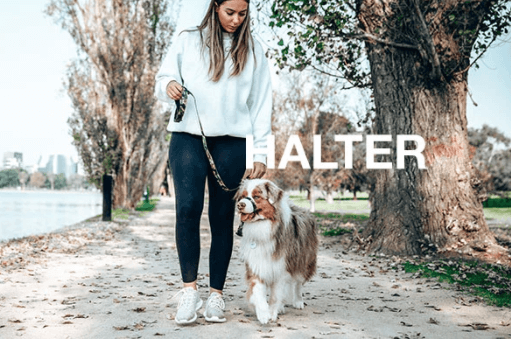A Dog Head Collar often referred to as a head halter, but its more blatant terms include ‘dog nose lead’ and ‘anti-pull head collar’—is a doggy training device for serial pullers and reluctant heelers. It’s a level up from the no-pull harness, which discourages pulling behavior and protects a dog’s trachea by redistributing lead-derived pressure from the neck to the torso.
What makes a head halter that extra bit effective? Well, if someone were holding your face at mercy, you’d probably obey them.
The halter fits over a dog’s snout, attaching behind the ears and under the chin, channeling leash tension to the mouth.
By resisting the tension, the dog risks compromising their jaw or teeth. (Halters are not confused with muzzles, which prevent the dog from opening its mouth.)
Should you choose to invest in a halter, you’ll need to commit to using it. It will be a bit like leash training all over again; a dog will naturally resist it.
So, long before you slide it on, get your dog to make positive associations with the halter. If they’re not comfy, that’s not good for anyone involved or nearby.
That Darned Oppositional Reflex
We just spoke of a dog’s tendency to naturally resist halters, leashes, or any restraint. This harks back to the canine instinct called oppositional reflex (or, for the technical term, thigmotaxis). What is it?
Well, the name is self-explanatory. If a dog feels tension pulling them one way, every cell in their body will tell them to pull the other way.
It’s unfortunate but, with the right training, they can ‘unlearn’ this behavior. This is what leash training is for.
If a dog didn’t quite overcome oppositional reflex during puppyhood, that’s where no-pull harnesses and halters can come in!
What is The Science Behind Dog Head Collar?
Well, there’s no ‘science’ behind it, but dog head collars (or halters) are built to work the same way as horse bridles. Pull the front of the body in one direction, and the rest will surely follow.
If the dog does not comply, the halter applies pressure to the nose. This pressure eases only when the dog reclaims control of their oppositional reflex (and, hence, the dog walker reclaims control of the dog.
It’s like a domino effect of control). The halter provides a form of negative reinforcement that discourages disobedient behavior.
Debatably, positive reinforcement plays a role, too—if you consider ‘not having your nose squished’ to be a reward.
Photo: Stylish Hound
Once your dog grows used to walking your way, they’ll be better suited to walking on looser leashes. As you’re training your dog, you can use the halter to your advantage.
Encourage good behavioral habits for the daily walk by harnessing and redirecting your dog’s forward pulling motion accordingly.
Is Negative Reinforcement A Negative Approach?
In a word: no! After all, this is a halter: not a shock collar. Dog head collars are used and promoted across dog training programs, vet clinics, and animal shelters.
Big dog-loving organizations such as the RSPCA and Guide Dogs Australia also endorse them. The dependent variable for a halter’s success is ultimately the human hands into which it falls.
What makes for good halter training? Be mindful of the fact that your dog’s mouth is sensitive and vulnerable to injury. When walking your haltered dog, refrain from sudden movements, lest you injure your dog.
Also, be mindful of halters that connect beneath the chin. When you apply pressure to the lead, such halters tend to close the dog’s mouth.
There is no actual training benefit to this, and it only cuts off the panting mechanism—aka the way a dog regulates their body temperature.
So, when training your dog, always be gentle, especially if you have a halter that connects this way.
Finally, ensure that the halter loosens when your dog walks the right way. Keep the tension consistent throughout, and your dog will be merely restrained.
In other words, without the reinforcement, they’ll be unequipped to discriminate between desirable and undesirable behavior. And you wouldn’t want all that time to have gone to waste, right?
To Dog Head Collar OR Not To Dog Head Collar?
This form of training can be a good option for puppies if you want to keep them straight and narrow immediately. Just ensure that they are
a) conditioned to wearing a collar and
b) at least eight weeks old before you get started.
It is also great for an adult dog who didn’t pass their training with flying colors (or somehow skipped training altogether).
However, if your dog has deeper behavioral issues, halter training is no substitute for professional training or behavioral therapy.
It can be a great fix, though, for surface issues such as pulling or obedience issues. If you think it could help your dog, why not give it a go?


